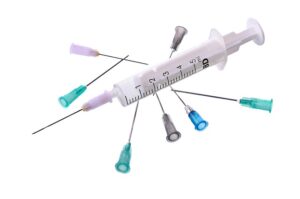Semaglutide, a GLP-1 receptor agonist, offers dual benefits in managing type 2 diabetes and obesity. Starting with low doses of 0.25 mg weekly, healthcare providers gradually titrate up based on patient tolerance and response. Individual factors like age, BMI, and kidney function guide optimal dosing, with close monitoring of blood glucose levels and adverse effects. Regular follow-ups are crucial to adjust semaglutide dosages for maximum therapeutic benefits while minimizing side effects like nausea, vomiting, and diarrhea.
“Discover the art of tailoring Semaglutide therapy through precise dosage adjustments. This comprehensive guide explores the intricate process of optimizing this potent medication for various therapeutic uses. From understanding its mechanism and initial dosing strategies to navigating patient-specific factors and monitoring progress, we delve into essential practices. Learn how to manage side effects and unlock advanced techniques for effective semaglutide dosing, ensuring optimal outcomes for your patients.”
Understanding Semaglutide and Its Therapeutic Uses

Semaglutide is a novel glucagon-like peptide-1 (GLP-1) receptor agonist that has gained significant attention in diabetes management. Its primary role is to stimulate insulin secretion in a glucose-dependent manner, thereby lowering blood sugar levels. This medication also promotes satiety, leading to reduced food intake and weight loss, making it valuable for treating type 2 diabetes and obesity. The therapeutic potential of semaglutide lies in its ability to mimic the natural hormone GLP-1, which regulates energy balance and metabolism.
The effectiveness of semaglutide therapy depends on the individual’s response, leading to dosage adjustments. Starting doses are typically low, allowing patients to tolerate the medication well. As with any drug, the prescriber will monitor the patient’s blood sugar levels and assess their response. Based on this assessment, the dose may be increased gradually up to a maximum threshold to achieve optimal glycemic control while minimizing adverse effects. Understanding these dosing considerations is crucial for both healthcare providers and patients using semaglutide to manage diabetes or support weight loss goals.
Initial Semaglutide Dosage: Starting Low and Titrating Up

When initiating treatment with semaglutide, it is recommended to start with a low dose and gradually increase it based on individual patient response. This titration approach allows for careful monitoring of side effects and ensures optimal dosing. Typically, patients begin with 0.25 mg once weekly and have the option to escalate to 0.5 mg or 1 mg after evaluating their tolerance and clinical response. The initial low dose helps minimize potential adverse reactions, such as nausea or diarrhea, which are common with semaglutide therapy.
By starting low, healthcare providers can assess each patient’s ability to tolerate the medication before increasing the dosage. This step-by-step process enables personalized treatment, ensuring that the prescribed semaglutide dose is suitable for the individual’s needs and helps maximize therapeutic benefits while minimizing risks.
Factors Influencing Dosage Adjustments: Patient Response and Individual Considerations

The effectiveness of semaglutide therapy largely depends on precise dosage adjustments, which are influenced by patient response and various individual considerations. Healthcare providers must closely monitor patients’ blood glucose levels and assess their clinical response to determine the optimal semaglutide dosing regimen. Factors such as age, body mass index (BMI), baseline glycemic control, kidney function, and concurrent medications can all play a role in how an individual metabolizes and responds to semaglutide.
For instance, patients with higher BMI or those with poor glycemic control at the start of treatment may require higher initial semaglutide doses to achieve target blood sugar levels. Conversely, elderly patients or individuals with kidney impairment might necessitate lower doses due to potential side effects or altered drug metabolism. Regular follow-ups and adjustments are crucial to ensure that the semaglutide dosing aligns with each patient’s unique needs, maximizing therapeutic benefits while minimizing adverse reactions.
Monitoring Patient Progress: Evaluating Efficacy and Safety

The effectiveness of semaglutide treatment is determined by closely monitoring patients’ progress and evaluating both its efficacy and safety. Regular assessments are crucial to adjust the semaglutide dosing regimen as needed, ensuring optimal results while minimising potential adverse effects. Healthcare providers should track key markers such as weight loss (or maintenance), blood glucose control, and any changes in metabolic parameters.
By regularly examining these factors, healthcare professionals can gauge whether the current semaglutide dosage is appropriate for each patient. This iterative process allows for personalized dosing adjustments, catering to individual responses and enhancing overall treatment outcomes.
Common Side Effects and Their Management During Dosing

Semaglutide, like any medication, comes with its share of side effects, which can vary in intensity and impact on individuals. Common experiences include nausea, vomiting, diarrhea, and stomach pain—often reported early in the treatment course. These symptoms usually subside as the body adjusts to the drug. Managing these side effects often involves simple strategies such as taking semaglutide with food or adjusting meal timings, ensuring adequate hydration, and incorporating light exercise into daily routines.
For patients experiencing more severe adverse reactions, like respiratory issues or persistent nausea, a healthcare provider might suggest temporary dose reductions or adjustments to the administration schedule. Regular monitoring during dosing is crucial to identify any concerning symptoms early on, allowing for prompt intervention and changes in semaglutide dosing regimens as needed.
Optimizing Semaglutide Therapy: Advanced Strategies for Dosage Adjustments

Optimizing Semaglutide therapy involves a nuanced approach to dosing adjustments, tailored to individual patient responses. Healthcare providers play a crucial role in fine-tuning semaglutide doses by closely monitoring key markers like glycemic control and adverse effects. This strategic navigation ensures that patients receive the most effective and safe dosage, ultimately enhancing treatment outcomes.
Advanced strategies for semaglutide dosing include iterative adjustments based on regular assessments, incorporating patient feedback, and leveraging dynamic models that predict response patterns. By adopting these sophisticated methods, healthcare teams can personalize treatment plans, achieving better blood sugar control while minimizing unwanted side effects.
